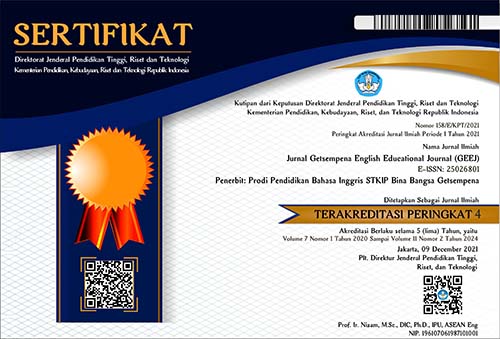DOES FLIPPED LEARNING WORK? A CASE FOR PRIVATE UNIVERSITY IN INDONESIA
Abstract
This study sought to find out the result of implementing Flipped Learning in pre-university English class in one of private universities in Indonesia. The study answers the question on to what extend the flipped learning work or fail when being implemented in the respective class. The data which were the result of pre-test and post-test were collected using quantitative method. To analyse the data, a non-parametric approach was used to analyse the impact of the FL approach on student performance in the EPS program. The difference between the pre- and test- scores was calculated and used in a hypothesis testing method using the Mann-Whitney-Wilcoxon Test. The result indicated that there is no significance difference between the treatment group and the control group. Some possible reasons why the insignificance happen are presented as well as some recommendations towards future studies in FL context.
References
Abdelshaheed B. S. (2017). Using flipped learning model in teaching english language among female english majors in majmaah university. English Language Teaching, 10(11), 96.
Alsowat, H. (2016). An EFL flipped classroom teaching model: Effects on English language higher-order thinking skills, student engagement and satisfaction. Journal of Education and Practice, 7(9), 108-121.
Anderson, D. R., Sweeney, D. J., Williams, T. A., Camm, J. D., & Cochran, J. J. (2014). Statistics for business and economics (12th ed.). Stamford, CT: Cengage Learning.
Baker, J. W. (2000). The ‘classroom flip: Using web course management tools to become the guide by the side. In J. A. Chambers (Ed.), Selected Papers from the 11th International Conference on College Teaching and Learning (pp. 9-17). Jacksonville, FL: Florida Community College at Jacksonville.
Basal, A. (2015). The implementation of a flipped classroom in foreign language teaching. Turkish Online Journal of Distance Education, 16(4), 28-37.
Bates, J. E., Almekdash, H., & Gilchrest-Dunnam, M. J. (2017). The flipped classroom: a brief, brief history. The Flipped College Classroom, (pp. 3-10). Springer, Cham.
Capone, R., De Caterina, P., & Mazza, G. (2017). Blended learning, flipped classroom and virtual environment: Challenges and opportunities for the 21st century students. Procedings of the 9th International Conference on Education and New Learning Technologies (Edulearn) 2017. Barcellona, Spain.
Collins, R. (2014). Skills for the 21st century: Teaching higher-order thinking. Curriculum & Leardership Journal Article: An Electronic Journal for Leaders, 12(14). Retrieved from http://www.curriculum.edu.au/leader/teaching_higher_order_thinking,37431.html?issueID=12910
Correa, M. (2015). Flipping the foreign language classroom and critical pedagogies: a (new) old trend. Higher Education for the Future, 2(2), 114-125.
Egbert, J., Herman, D., & Chang, A. (2014). To flip or not to flip? That's not the question: Exploring flipped instruction in technology supported language learning environments. International Journal of Computer-Assisted Language Learning and Teaching (IJCALLT), 4(2), 1-10.
Gaughan, J. E. (2014). The flipped classroom in world history. The History Teacher, 47(2), 221-244.
Ginola, D., & Sidabalok, D. M. (2016, May). The implementation of flipped classroom by using schoology in speaking II class of English education study program of teacher training and education faculty of bandar lampung university. In International Conference on Education and Language (ICEL), (p. 199).
Gorzycki, M. (n.d.). Student-centered teaching. Retrieved from https://ctfd.sfsu.edu/content/student-centered-teaching
Herreid, C. F., & Schiller, N. A. (2013). Case studies and the flipped classroom. Journal of College Science Teaching, 42(5), 62-66.
Jaster, R. W. (2017). Student and instructor perceptions of a flipped college algebra classroom. International Journal of Teaching and Learning in Higher Education, 29(1), 1-16.
Karimi, M., & Hamzavi, R. (2017). The effect of flipped model of instruction on efl learners’ reading comprehension: Learners’ attitudes in focus. Advances in Language and Literary Studies, 8(1), 95-103.
Kim, J. E., Park, H., Jang, M., & Nam, H. (2017). Exploring flipped classroom effects on second language learners’ cognitive processing. Foreign Language Annals, 50(2), 260-284.
Love, B., Hodge, A., Grandgenett, N., & Swift, A. W. (2014). Student learning and perceptions in a flipped linear algebra course. International Journal of Mathematical Education in Science and Technology, 45(3), 317-324.
Lyddon, P. A. (2015). The flip side of flipped language teaching. Critical CALL–Proceedings of the 2015 EUROCALL Conference, Padova, Italy (p. 381-385).
Marcellino, M. (2015). English language teaching in Indonesia: A continuous challenge in education and cultural diversity. TEFLIN Journal, 19(1), 57-69.
Mattarima, K., & Hamdan, A. R. (2011). The teaching constraints of English as a foreign language in Indonesia: the context of school based curriculum. Sosiohumanika, 4(2).
McCallum, S., Schultz, J., Sellke, K., & Spartz, J. (2015). An examination of the flipped classroom approach on college student academic involvement. International Journal of Teaching and Learning in Higher Education, 27(1), 42-55.
Milman, N. B. (2012). The flipped classroom strategy: What is it and how can it best be used?. Distance Learning, 9(3), 85.
Østerlie, O. (2016). Flipped learning in physical education: Why and how?. Physical Education and New Technologies, (pp. 166-176).
Roehl, A., Reddy, S. L., & Shannon, G. J. (2013). The flipped classroom: An opportunity to engage millennial students through active learning strategies. Journal of Family & Consumer Sciences, 105(2), 44-49.
Sangoleye, S. A., & Kolawole, C. O. O. (2016). A Critique of Selected Instructional Strategies in Higher Institutions in Nigeria. Journal of Education and Practice, 7(7), 78-84.
Schmidt, S, & Ralph, D. (2016). The flipped classroom: A twist on teaching. Contemporary Issues in Education Research, 9(1), 1-6.
Seery, M. K. (2015). Flipped learning in higher education chemistry: emerging trends and potential directions. Chemistry Education Research and Practice, 16(4), 758-768.

























